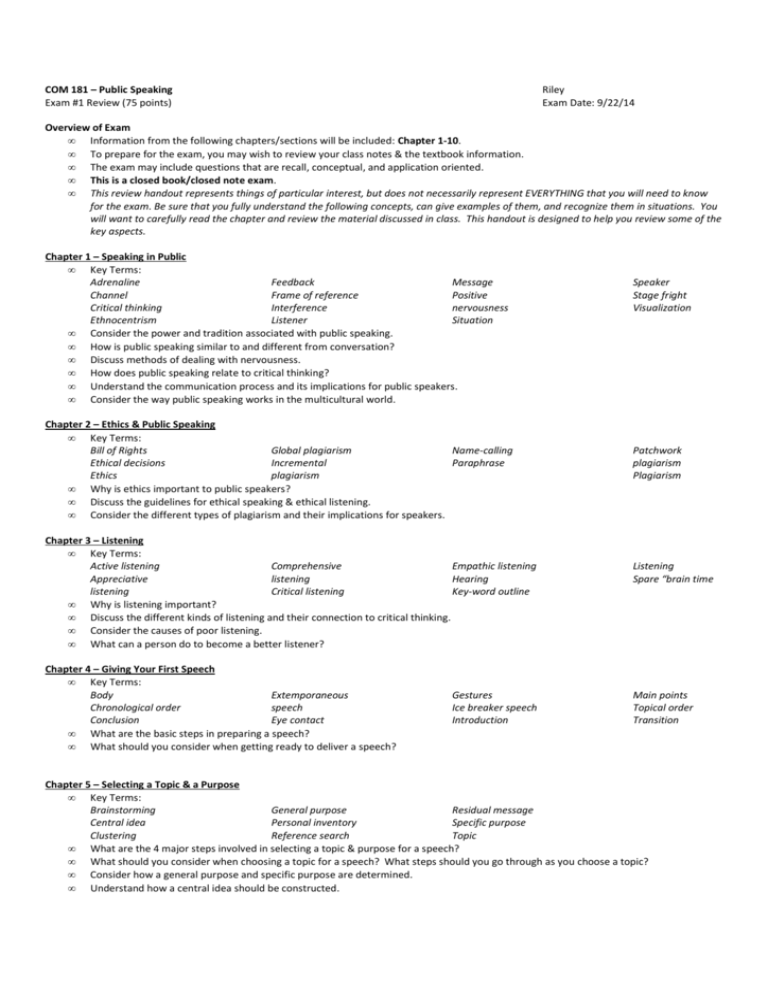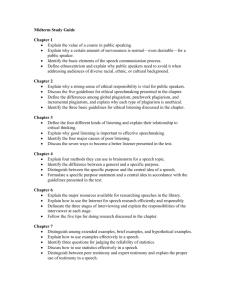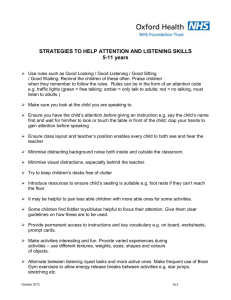COM 181 – Public Speaking Riley Exam #1 Review (75 points
advertisement

COM 181 – Public Speaking Exam #1 Review (75 points) Riley Exam Date: 9/22/14 Overview of Exam • Information from the following chapters/sections will be included: Chapter 1-10. • To prepare for the exam, you may wish to review your class notes & the textbook information. • The exam may include questions that are recall, conceptual, and application oriented. • This is a closed book/closed note exam. • This review handout represents things of particular interest, but does not necessarily represent EVERYTHING that you will need to know for the exam. Be sure that you fully understand the following concepts, can give examples of them, and recognize them in situations. You will want to carefully read the chapter and review the material discussed in class. This handout is designed to help you review some of the key aspects. Chapter 1 – Speaking in Public • Key Terms: Adrenaline Feedback Message Channel Frame of reference Positive Critical thinking Interference nervousness Ethnocentrism Listener Situation • Consider the power and tradition associated with public speaking. • How is public speaking similar to and different from conversation? • Discuss methods of dealing with nervousness. • How does public speaking relate to critical thinking? • Understand the communication process and its implications for public speakers. • Consider the way public speaking works in the multicultural world. Chapter 2 – Ethics & Public Speaking • Key Terms: Bill of Rights Global plagiarism Name-calling Ethical decisions Incremental Paraphrase Ethics plagiarism • Why is ethics important to public speakers? • Discuss the guidelines for ethical speaking & ethical listening. • Consider the different types of plagiarism and their implications for speakers. Chapter 3 – Listening • Key Terms: Active listening Comprehensive Empathic listening Appreciative listening Hearing listening Critical listening Key-word outline • Why is listening important? • Discuss the different kinds of listening and their connection to critical thinking. • Consider the causes of poor listening. • What can a person do to become a better listener? Chapter 4 – Giving Your First Speech • Key Terms: Body Extemporaneous Chronological order speech Conclusion Eye contact • What are the basic steps in preparing a speech? • What should you consider when getting ready to deliver a speech? Gestures Ice breaker speech Introduction Speaker Stage fright Visualization Patchwork plagiarism Plagiarism Listening Spare “brain time Main points Topical order Transition Chapter 5 – Selecting a Topic & a Purpose • Key Terms: Brainstorming General purpose Residual message Central idea Personal inventory Specific purpose Clustering Reference search Topic • What are the 4 major steps involved in selecting a topic & purpose for a speech? • What should you consider when choosing a topic for a speech? What steps should you go through as you choose a topic? • Consider how a general purpose and specific purpose are determined. • Understand how a central idea should be constructed. Chapter 6 – Analyzing the Audience • Key Terms: Attitude Egocentrism Open-ended AudienceFixed-alternative questions centeredness questions Scale questions Demographic Identification Situational audience analysis audience analysis • Why is audience-centeredness important? • Discuss the psychology of audiences. • Consider the information gained from a demographic audience analysis & situational audience analysis. • How can you get information about the audience? • What kinds of questions can you ask to get information about the audience? • Discuss how you can adapt to the audience before & during a speech. Chapter 7 – Gathering Materials • Key Terms: Abstract Newspaper & Primary source Academic database periodical database Reference work Call number Preliminary Research interview Catalogue bibliography Secondary source • How does your own knowledge and experience influence the research process? • Consider the different resources you have for doing research. • What is the difference between primary & secondary sources? • Discuss the steps for choosing support? • Consider the types of Internet resources available & special considerations for evaluating them. • What should you do before, during, & after an interview? • Discuss additional tips for doing research. Chapter 8 – Supporting Your Ideas • Key Terms: Brief example Hypothetical Paraphrase Direct quotation example Peer testimony Example Mean Quoting out of Expert testimony Median context Extended example Mode Statistics • What does it mean to have a “responsible knowledge”? • Discuss the three main types of support used during speeches? • How do you evaluate each type of support? • What does each type of support offer the speaker? • What information needs to be included in a verbal citation? How do you choose what to include? Chapter 9 – Organizing the Body of the Speech • Key Terms: Causal order Main points Signpost Chronological order Problem-causeSpatial order Connective solution order Stock issues format Internal preview Problem-solution Strategic Internal summary order organization • Why is organization important? • Understand the basics of good form. • Consider the different organizational patterns. • How do you choose an organizational pattern? What are some issues to consider while choosing main points? • Discuss the use of connectives. Chapter 10 – Beginning & Ending the Speech • Key Terms: Credibility Dissolve ending Preview statement Crescendo ending Goodwill Rhetorical question • Why are introductions important? How much of your speech should the introduction make up? • What should an introduction do? What should be included in an introduction? • How do you select an introductory tactic? • Why is a conclusion important? How much of your speech should the conclusion make up? • What should a conclusion do? What should be included in a conclusion? Stereotyping Sponsoring organization Virtual library Supporting materials Testimony Supporting materials Topical order Transition






